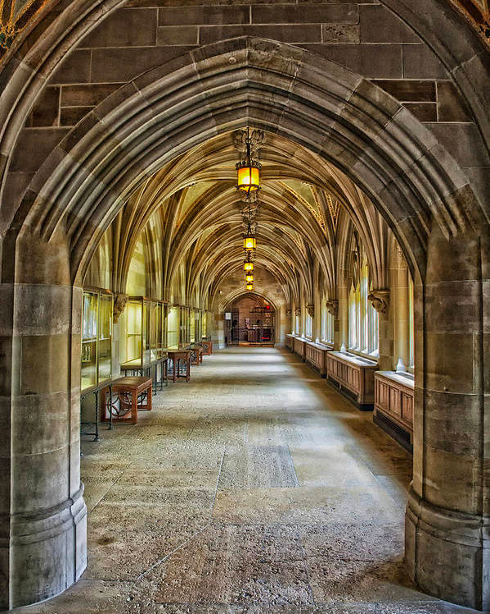Dark Academia
Edited by Olivia Stowell and Mitch Therieau
Introduction
"There are over a million posts on the 'dark academia' tag on Instagram," Jacobin reports. "Between the start of the pandemic and the spring of 2021," The New Statesman breathlessly announces, Google logs a staggering "4,750 per cent rise in searches for the phrase." The non-extremely-online reader confronted with this not-quite-news would be forgiven for coming away with the impression that dark academia begins and ends in the realm of the keyword, the search term, the hashtag. It may seem as if so many people are talking about dark academia simply because so many people are talking about it.
Those who have been initiated into its mysteries know better. For dark academia's legions of fans — and fans they surely are, strange as it may seem to profess fandom for an apparently abstract category — dark academia is at least two things. On one hand, it is an online subculture, a constellation of spaces on Tumblr, TikTok, and Instagram dedicated to a certain idea of the (typically midcentury) fashion and material culture of elite universities and their wealthy students. In these spaces, aspiring dark academics trade fashion tips and curate collections of images they find especially "aesthetic": wool cardigans, musty libraries, pre-Raphaelite paintings.

On the other hand, dark academia is also a burgeoning literary subgenre. Curiously, despite the self-conscious bookishness of dark academia's online spaces, much of the copious lifestyle reporting on the phenomenon overlooks its more immediately literary life. In the realm of fiction, the term names a type of campus-intrigue novel that takes its cues from Donna Tartt's The Secret History (1992). These novels, which remix tropes from the gothic, the detective novel, and other genres, have enjoyed immense success in the literary marketplace over the past few years, particularly in the YA category. Like online dark academia communities, dark academia fictions are filled with characters who obsess over the aesthetic trappings of academic life — and who are determined to obtain them through any means necessary, be it magic or murder.
All of this is to say that dark academia itself, like so many of its characters, leads at least a double life. This doubling — and not to mention the feedback loop it creates, with books inspiring scores of blog posts and podcasts, which in turn spawn more books — presents a challenge for scholars of contemporary culture. How are we to grasp, let alone classify, a slippery concept that serves both as a market category within the publishing world and as an organizing term for a decentralized network of online communities?
Is dark academia a genre? To think about dark academia this way would be to understand genre not only as an organizing principle for fiction, but also — taking a cue from Lauren Berlant — as a set of fantasmatic scripts and props that sustain our desires, whether on- or offline. Genre as narrative; genre as lifestyle. Or should we tune in to the argot of online life and understand dark academia as a vibe: a curatorial principle that sorts content not by its membership in established genres, but by the moods it evokes? Or, more broadly still, is dark academia perhaps not so much a grouping of cultural objects as a structure of feeling, a cluster of attachments to exploitative institutions that either don't love us back or never let us in in the first place? The essays in this cluster probe all three of these possibilities. Far from competing with one another, these three rubrics help us understand dark academia as a mobile aesthetic formation that operates on a range of scales — from the stylistic tics of a text to the grim machinery of the neoliberal university itself.


That grim machinery is at its most overt in plans for eleven-story windowless dorm buildings, lawsuits alleging that student loan companies dispense predatory loans and universities themselves illegally collude to restrict financial support, or university presidents using their work emails to engage in inappropriate relationships with their subordinates. Yet these outsized, memeable events don't even capture the quotidian cruelty of life in the university for many, if not most, of its workers. All this is to say: the subterfuge and abuse endemic to the plots of dark academia fictions may not be so far adrift of the day-to-day workings of the contemporary university.
It is not especially hard to locate a historical reason for this resonance between the aestheticized violence of dark academia and the misery of daily life in the university. Dark academia, both as online phenomenon and as literary category, acquired conceptual solidity around the mid-2010s, the era of the neoliberal university's post-financial-crisis tailspin. As universities scrambled to enact austerity measures, ruthlessly cutting tenure-track faculty lines while luring students with promises of a deluxe consumer "educational experience" — at the cost, for many, of a lifetime of student debt — there was perhaps an especially acute sense that the "life of the mind" aestheticized in dark academia was unevenly distributed at best, and pure fantasy at worst. During the pandemic years, dark academia has passed from subculture to the mainstream, from online enclave to "Gen Z's favorite look," suggesting that the process grinds on: the further the idealized vision of campus life slips out of reach for academic workers and students alike, the more acolytes dark academia gathers.
Gathers to what end? What does dark academia finally do with the fantasies it traffics in? Broadly speaking, two opposing positions have emerged: either dark academia is democratizing, making the trappings of elite education more widely available by reducing them to so many images, so many vibes, or else dark academia is a palliative supplement to an increasingly expensive, instrumentalized, and ultimately hollow higher education — an illusion of a university that "works." Whatever the relative strengths of these positions, we are largely uninterested in debating whether dark academia is straightforwardly "good" or "bad." Rather, we consider how various aesthetic objects might conjure up these positions toward a variety of ends.
The work of this cluster is to hold dark academia up to the light — both to focus its dispersed elements into something solid and theorizable, and to refract it into its constituent parts. Our contributors attend to novels, television, video games, TikToks, Tumblr posts, YouTube videos, academic theories and debates, and activism within and outside the academy. They identify structures that obtain across these far-flung domains and, just as crucially, recover a sense of their objects' weird singularity — all while resisting received notions about which objects we should take seriously and how we should write about them.
***
What better place to begin than the dark academic ur-text, The Secret History? Gunner Taylor offers a reading of Tartt's novel as a staging ground for clashes between genres — a reading that challenges us to expand our notions of genre, and that brings the submerged class politics of genre bubbling to the surface. Taking Tartt as a departure point, Olivia Stowell turns her attention to the recursive, looping chronologies of dark academia fictions, theorizing these narrative structures as simultaneously reflections of and imaginative solutions for "the feeling of no future." These feelings of dead-ended stuckness also permeate the "novels of precarity" that Deborah Thurman analyzes — novels where the academic job market looks a lot like the sentimental novel's marriage market, and where protagonists confront their own fungibility as seemingly interchangeable warm bodies.
Bridging the narrative and the digital, Mitch Therieau takes dark academia as an especially productive site to track the mediations between literature and platform-based digital media — and maybe more importantly, these objects' growing consciousness of their own status as therapeutic, mood-enhancing instruments. Amatulla Mukadam dives into her personal experiences on dark academia Tumblr in the 2010s, unearthing her own shifting attachments to and disenchantments with the romanticized view of education that dark academia projects. Mel Monier turns their eye toward the kinetic whirl of TikTok, where Black women content creators are not just resisting dark academia's overwhelming whiteness, but also refiguring dark academic images and tropes to speak to their own experiences, desires, and pleasures. Caroline Mann and Lucia Tang pick up the thread of dark academia's pleasurable appeal, underlining the challenges of shaking off our attachments to academia and the unexpected objects that can reveal the persistence of our fantasies of (dark) academic life.
Dylan Davidson finds perhaps the most stubborn of these fantasies, the "longing to be transformed" by academic experiences, encoded at the core of the concept of "the aesthetic" — a fantasy that animates dark academia fandoms and university fundraising campaigns alike. Speaking of funds: Annie Bares's essay constellates dark academia with "dark money," identifying representations of philanthropy across novels, television, and campus PR materials as sites where academia's supposedly transformative promises curdle. Rachel Tay finds more rotten promises within the humanities themselves, arguing that the friction between the desire for a life of the mind and the material necessity of making a living has shaped the approaches academics have taken to their objects of study. And yet where there are unrealizable fantasies and rancid attachments, there is also hope. Hannah Alpert-Abrams and Saronik Bosu extend a vision of what solidarity within and beyond the academy can look like, presenting the Visionary Futures Collective's understanding of magic as a possible framework "for shared vulnerability, for transparency, for collective action" — salvaging dark academia, as it were, for parts; taking the magic and leaving the elitist individualism.
In bringing these essays together, we offer a preliminary theorization of what dark academia is and means for literature, for media, for the academy — but more importantly for those like and with us: a diffuse community of knowledge workers within and beyond the academy who share a mutual interest in our collective life together. We also hope that this cluster's lines of inquiry can begin to spark new conversations, catch new refractions, beyond the spectrum gathered here. Dark academia has been criticized, damningly, for being fundamentally incapable of imagining the university as anything other than set dressing for a drama of solipsistic self-improvement and cutthroat competition. And yet the process of editing this cluster and thinking alongside its contributors has buoyed our faith in the existence of collectives — even the contingent ones that form around thinking and writing about these kinds of objects — that can provide viable alternatives to these narrow, hierarchical imaginings of what academic life should be.
Is this to claim that the real dark academia, as it were, is the friends, the colleagues, the comrades we made along the way? Just the opposite: it is to say that the real source of the magic that transfigures concepts into their apparent opposites — criticism into friendship; dark academia into a source of hope amid the wreckage of the neoliberal university — is no clever aesthetic device or arcane theoretical trick. It is, as it has always been, the practical act of building something together.
References
- We thank Mark McGurl for the wonderful phrase "institutional gothic."[⤒]
Past clusters
Abortion Now, Abortion Forever
African American Satire in the Twenty-First Century
Contemporary Literature from the Classroom
Ecologies of Neoliberal Publishing
Feel Your Fantasy: The Drag Race Cluster
For Speed and Creed: The Fast and Furious Franchise
Keywords for Postcolonial Thought
Leaving Hollywoo: Essays After BoJack Horseman
Legacies — 9/11 and the War On Terror at Twenty
Minimalisms Now: Race, Affect, Aesthetics
Mobilizing Literature: A Response